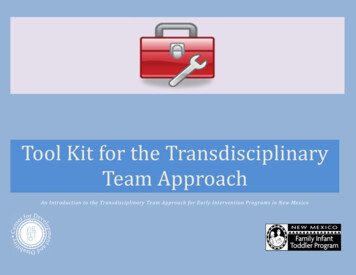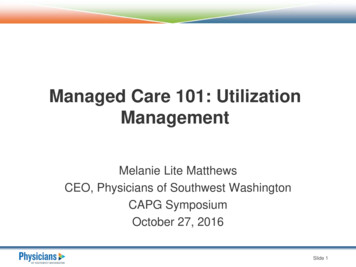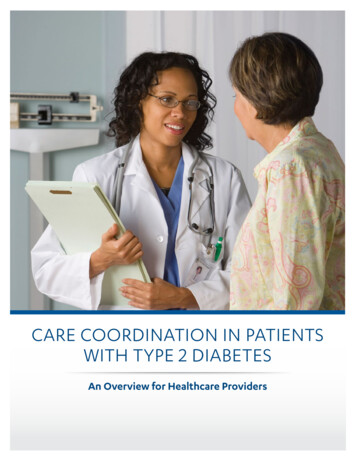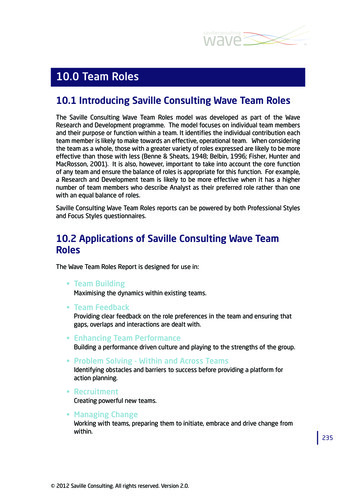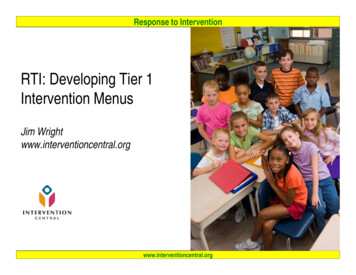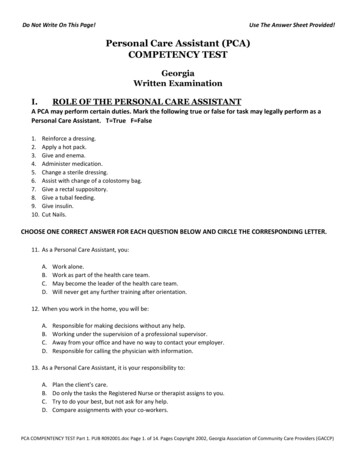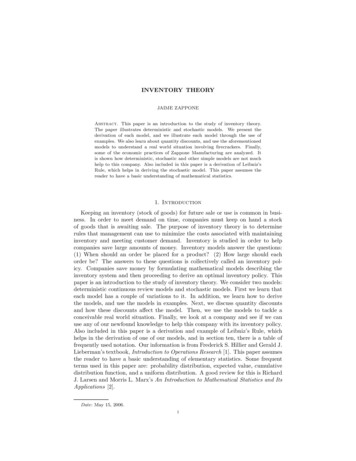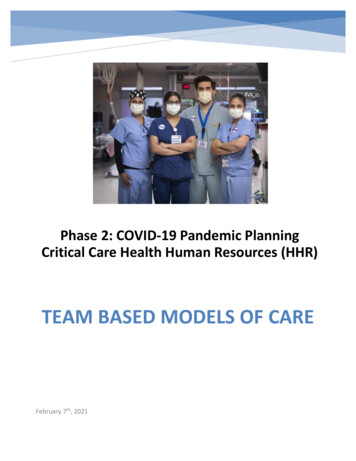
Transcription
Phase 2: COVID-19 Pandemic PlanningCritical Care Health Human Resources (HHR)TEAM BASED MODELS OF CAREFebruary 7th, 2021
Phase 2 COVID-19 Pandemic Planning: Team Based Models of CarePurposeThis document is based on the COVID-19 Wave 2 Critical Care Health Human Resource (HHR) Response Planreleased by the Critical Care Command Centre, September 21, 2020. The purpose is to provide guidance fororganizations activating Team Based Models of Care in response to COVID-19 pressures, as an essential strategyto increase health human resource capacity, in both acute care and critical care settings. Team Based Modelssupport patient care during pandemic times by enabling flexible team compositions whereby experiencedhealth care providers work together with team members across professions and roles to provide care that maybe different than their traditional scope. This document describes planning, implementation and evaluationresources that can be used to advance Team Based Models as they progress from Contingency to Crisis phases.In this way we can ensure we continue to provide safe, high quality patient care, and support the experienceand wellness of our health care teams. For the purpose of this document, a critical care team model consists ofcritical care trained and non-critical care trained individuals working together.TABLE OF CONTENTSHealth Human Resource Response Framework .2Overview of Team Based Models of Care .4Identify Expanded Pipeline . 5Workforce Skills Alignment . 6Team Based Models in Critical Care and Acute care . 7Critical Care Team Based Concept . 8Acute Care Team Based Concept . 10Progression of the Model from Contingency to Crisis Phase . 10Roles in Critical Care . 12Roles in Acute Care . 12Team Based Learning . 15Critical Care/Covid Care Learning Platform . 15Quick ICU Training . 16Educating Teams for Success During Wave 2 COVID-19: From Simulation to Bedside . 16Putting it All Together: Lessons Learned from Wave 1 . 17Supporting Documents and Acknowledgements .211 P a g e
Phase 2 COVID-19 Pandemic Planning: Team Based Models of CareHEALTH HUMAN RESOURCE STAGED RESPONSE FRAMEWORKThe Ontario Critical Care COVID-19 Command Centre released the Health Human Resource (HHR) ResponseFramework to guide hospitals, regions and the province to ensure a coordinated response during future waves ofCOVID activity. The following assumptions informed the development of the framework:1.2.3.4.5.6.7.8.A staged approach will ensure an integrated and coordinated provincial HHR response.Planning within regions will ensure a staged response is relevant and applicable within each geographic area.To inform each stage, hospitals and regions will monitor triggers that include % critical care occupancy, patientacuity (e.g. NEMS), staffing capacity (determined by both % variation from baseline of critical care staff), andconduct self-assessments.Nursing and other health disciplines are in-scope recognizing that there is an interdependency with thephysician coverage model.A complete hospital and/or regional response will include approaches to HHR, supplies (e.g., PPE), equipment,technology, and space/capacity. HHR is a primary consideration.Nursing practice expectations will be aligned to the Canadian Standards for Critical Care Nursing Practice.It is not realistic or appropriate to reduce all scheduled clinical activity. Some scheduled activity will continueand be balanced against critical care bed and HHR capacity requirements.Extreme COVID-19 surges may require a temporary net new increase in the number of critical care bedsand/or HHR.Health Human Resource Response Framework2 P a g e
Phase 2 COVID-19 Pandemic Planning: Team Based Models of CareStage Progression and TriggersTriggers for each stage, Conventional, Contingency and Crisis define required hospital and regional responses. TheContingency phase requires hospitals to respond by implementing Team Based Models. Triggers within the CrisisPhase require organizations to expand Team Based Models, ensuring they have maximized internal pipelines ofavailable staff and determine how to access new external pipelines. As capacity pressures and the need foradditional nursing staff increases, Team Based Models must move along a progression to include increasedintegration of clinical and support roles, from both internal and external pipelines. The HHR Guiding Principlesprovide the foundation for ensuring the continued delivery of safe care, through the potential progression ofphases from Contingency to Crisis.HHR Guiding Principles Patient and staff safety will remain a top priority. Leverage existing HHR capacity to supplement critical care units Ensure roles and responsibilities are clear for team members, particularly as teams expand. Maintain sufficient levels of expertise in each area; utilize Team Based Models and ensure expertise isavailable to less experienced staff Operational capabilities will be flexible, scalable and adaptable to support the response. Partnerships among critical care units within individual hospitals and regions will be essential to support eachother with equipment, personnel, decanting non-COVID patients, etc. Routine, standardized communication will ensure all team members are informed and aware of current needs,stage, and impact of the response. Strategies to support staff wellness must be integrated in every stage of response. Mechanisms should be in place to support ongoing evaluation while models are in operation to ensure quality,patient and staff safety are top priority. Readiness to act during all stages of surge will follow the Critical Care Surge Capacity ManagementFramework, found in the Critical Care Services Ontario (CCSO) Surge Capacity Management Plan ge-capacity-management-plan/ Implementation of proactive HHR approaches should contribute to the avoidance of hospital(s) and/orregion(s) from going into crisis. Staff with advanced skill levels should be prioritized to support Critical Care teams given the higher patientacuity. Emergency Orders – Applicable components should be considered in HHR system planning (e.g. staffredeployment3 P a g e
Phase 2 COVID-19 Pandemic Planning: Team Based Models of CareOVERVIEW OF TEAM BASED MODELS OF CAREIn Team Based Models experienced staff partner with staff who have varying levels of skill and may have beenredeployed from different settings. Redeployed staff may also fulfill new roles (e.g. Alternate Care Provider, SafetyOfficer, Support, Helper) that have been designed to support patient care and teams during pandemic times. Theseroles can be operationalized by individuals regardless of professional background or experience. New teammembers are provided with just-in-time education to support familiarization within the clinical setting, tomaximize and build on their existing skill sets.Experienced critical care nurse and acute carenurse work together to care for a patient inthe critical care setting.TEAM BASED MODEL OF CARE FRAMEWORKThe Team Based Model of Care Framework provides a structure for the planning, implementation and evaluation.Each component will be described in more detail to provide organizational guidance.4 P a g e
Phase 2 COVID-19 Pandemic Planning: Team Based Models of CareIDENTIFY EXPANDED PIPELINEContigency Team Based Models are currently in place in varying degrees across organizations. In the current statesome organizations have implemented upskilling of staff to prepare, pilot testing of new care delivery models,redeployment of clinical staff through limited reduction of services, and activation of expanded models whereCOVID pressures have been significant. Preparing for the Crisis phase requires new HHR pipelines to be maximized,to enable team expansion. Internal and external pipelines provide staff who can be redeployed into either acutecare or critical care. Redeployment of staff into Team Based Models in Acute Care can release staff with higherskill levels to support expanded Team Based Models in Critical Care.What opportunities for internal hospital, regional and provincial levers/strategies could beimplemented to advance Team Based Models?Internal Hospital Pipeline Examples: Inventory and up skilling of all clinically trained/non-bedside staff to fill defined needs and roles (e.g. clinicalinformatics, professional practice, etc.). Nurses (RNs/RPNs) in Resource Teams, ambulatory care, clinics, and settings such as transitional care, rehaband palliative care, up skilled to support acute care models Team based models in acute care to release nurses to assume ICU Extender role Non-hospital community physicians/specialists to support all adjunct clinical work (e.g. vaccination, COVIDtesting, ambulatory services, assume roles in the ED to shift ED physicians to critical care). Assistance from hospital volunteers. Maximize part time/casual staff in critical care or backfill acute care to send staff to critical care. Optimize teams in all L3, L2 ICUs for hospitals in moderate surge or hot spots. Utilize team skills in settings such as coronary care, cardiology or stroke to create capacity in ICUs by decantingselect patient populations. Consider recruitment of retired health care providers in all disciplines.5 P a g e
Phase 2 COVID-19 Pandemic Planning: Team Based Models of CareExternal Pipeline Examples (Regional and Provinical)Clinical Externs Broaden Clinical Extern Program to include other health disciplines students e.g., medical, paramedic,respiratory therapy and nursing students (for more information, refer to the Ministry of Health ExpandedExtern Program)Regional and Provinical Deployment Leverage provinical/regional programs that may assist with the redeployment of staff from other regionsredeployed staff might include other hospital or health sector staff (e.g., community clinical staff, healthprofessionals from correctional facilities, physician offices, military and Family Health Teams etc). Paramedics redeployed to hospitals. Consider recruitment of non-traditional regulated roles who could perform some tasks. High school students to perform specific tasks under the direction of health care professionals. Internationally trained health care providers capable of working in modified or monitored clinical role.WORKFORCE SKILLS ALIGNMENTThe Skills Assessment Tool can be broadly distributed to staff in both internal and external pipelines to categorizenurses and health professions by level of skill (ABCD). Using a consistent tool and language enables effective andefficient collaboration and coordination across organizations and regions for staff education, workforce alignmentand redeployment. Models of care and roles can be designed using the skill categories to determine the number ofstaff required in each category to expand clinical capacity, while ensuring there is a balanced distribution of clinicalexperience.Skills Assessment Tool6 P a g e
Phase 2 COVID-19 Pandemic Planning: Team Based Models of CareTEAM BASED MODELS IN CRITICAL CARE AND ACUTE CAREThe design and implementation of Contingency Models of care is important in both the acute care and critical caresettings. Model concepts have been designed for both areas, and are provided below. Organizations areencouraged to customize the models to best meet the needs of unique clinical contexts, patient populations, andstaff requirements. The expedited development of contingency models should consider: Patient needs assessment data (acuity, complexity, dependency), including specialty care requirements forspecific populationsWorkload measurement data Patient flow data and volume, as well as anticipated pandemic service adjustments Unit layouts and other contextual variables that influence unit capacity ( e.g. Rapid Response Team/ CodeBlues service, break capacity, access to RN consultation) Workforce data, including experience levels of unit teams Quality and safety dataUnit leaders and expert clinician perspectives should be integrated in the planning and development of models ofcare. The contingency models will require iterative enhancements, based on team learnings. Developmentalevaluation principles should be implemented through all stages of application.Professional Practice ConsiderationsPractice considerations and implications related to scope of practice, as per theRegulated Health Professional Act (1991) should be considered during modeldevelopment and iterative enhancements. Practice leader consultation andregulatory standards should be integrated to support decision-making for assignedand delegated tasks.Role responsibilities should be defined and communicated with teams, as well asensuring clarity in relation to regulated health professionals’ accountability foractions, in the COVID-19 environment (e.g. CNO ctice-resources/). Experienced team members, as well asredeployed team members may be concerned about the impact of practicechanges, and clarification should be provided. Support strategies andcommunication techniques to address practice changes with teams are important,including town halls, practice alerts and value prioritization through Process PriorityMapping. Teams working with unregulated health care professionals should befamiliar with the College of Nurses of Ontario’s practice guidelines, andconsideration given as to how to integrate the guidelines into workflow.Delegations and medical directives should be developed and expedited as required.In certain scenarios, attemptsshould be made to retain thecurrent base-line model.For example, critical care patientswith the highest acuity andcomplexity, and leastpredictability, may benefit fromcare in the standard model.Safety is considered when makingmodel adjustments, as well as theskill and competency level ofonboarded team members.Patient assignments, in both acute care and critical care, should consider the patient needs and acuity, as well asthe competencies and skill of the team members providing care. Efforts should be made to create safe andequitable assignments, ensuring the most acute and complex patients receive care from experienced nurses, orhave access to consultation and support. Team leaders/charge nurses need to be well versed with the skill levelsand capacity of new team members, to facilitate assignment creation.7 P a g e
Phase 2 COVID-19 Pandemic Planning: Team Based Models of CareEngagement of Physicians as Non-Physician ExendersIn many under-resourced enviroinments across the world, there are periods and situations when physicians arerequired to function in a broader clinical role than is typical in highly resourced settings. For example, in manysituations where demand for care exceeds capacity for some highly skilled health care personnel, physicians doexpand their role to encompass tasks more typically performed by nurses, pharmacists, respiratory therapists andothers. This is an unusual occurrence in Canada, however, at times during the COVID outbreak there has been arelative shortage of nurses and respiratory therapists in acute and critical care areas. Alongside this relativeshortage, there have been occasions due to service slowdowns in other areas of the health care system (e.g.procedural care and operations) where physician groups may have capacity to assist non-physicians as extenders.This atypical model deserves exploration in order to identify the opportunites, barriers and challenges; butrepresents a promising and potentially necessary application of interprofessional collaboration in order to ensurepatients receive the the best possible care at all times. For example, in an ICU experiencing a relative shortage ofnursing staff, it may be that anesthesia, critical care or acute care physicians with sufficient practical interprofessional mentoring and oversight, training – on equipment such as transfer of accountability, charting,medication preparation, bedside patient care, intravenous pump, bedside monitor, operation, etc. – to function asa nurse extender. For example, this might allow one-to-one clinician-to-patient ratios where two clinicians at twopatient bedsides are physicians who are supervised by an experienced ICU nurse. This is a model that is currentlyunder exploration and development but one example of out-of-the box thinking on patient care models that thispandemic has demanded we investigate.CRITICAL CARE TEAM MODELIn this model, critical care trained and non-critical care trained individuals work together in a team approach,called a HUB. Additional skills education is provided to support staff who don’t ordinarily work in critical care.Critical Care HUB Model*Adapted from Critical Care During a Pandemic (April 2006), lic/php/21/21 report.pdf8 P a g e
Phase 2 COVID-19 Pandemic Planning: Team Based Models of CareUsing the Skills Assessment Tool, critical care nurses can fall under the category of both skill level A and B. Level Aincludes full scope critical care nurses who are able to work independently in a critical care environment. Level Bincludes nurses who have critical care training, however have limited experience. They are able to support care in apartnered model or work independently to care for Level 2 patients. With additional support and experience, LevelB nurses transition to Level A.To further expand the workforce capacity, acute care nurses in the Level C category can be educated to partnerwith a critical care nurse. In further expanded models, the partner could additionally include other team membersbut not limited to physicians, respiratory therapists, and clinical externs. Based on this concept, teams can expectwide variation in expertise and experience. While some team members may bring specific clinical experience suchas invasive monitoring, non-invasive ventilation and/or vasoactive drugs (e.g. redeployed coronary care nurses orpost anaesthetic care unit (PACU) nurses), they may not have experience with invasive mechanical ventilation. Forthis reason, there are a variety of ways that the model can be flexibly operationalized on a daily basis. Decisionmaking is additionally dependent on level of acuity within the setting. Below are examples of different ways toimplement the team-based concept.1.2.3.Partnered in a Hub: A non-ICU nurse may be assigned to work in partnership with one Level A nurse who has 2or more patients. The Level A nurse will be the primary nurse and act as a preceptor to the non-ICU nurse.Runner or Support Role: A non-ICU nurse may be assigned a runner role that could include regular rounds toassess medication and supply needs, sign out and delivery narcotics, medications or supplies.Independent Assignment: A non-ICU nurse may be assigned to a patient who does not need a critical carenurse. A stable patient who is waiting for a bed on the ward or requiring nursing care consistent with a nonICU nurse.Example: Considerations When Making an AssignmentABCDExperienced FullScope Critical CareNurseNovice Critical CareNurse DevelopingExpertiseFormer Critical CareNurseNon Critical CareNurseAttempt to assign atleast oneexperienced criticalcare nurse to eachBay.Consider the acuityof the assignmentand other patientsin the Bay.Assignment basedon the individualnurse andcompetence.For high acuity,balance experience.Identify preceptoror resource nursefor support.Increase based onpatient acuity.Assign as required:Assigned topreceptor.Runner/SupportPartner withexperienced CriticalCare Nurse in HUBIndependentassignment for noncritical care patientIdentify a preceptoror resource nurse.9 P a g eOrientationAs orientationprogresses considerplacement ofstrongest orienteeto support areaswith greatest need.
Phase 2 COVID-19 Pandemic Planning: Team Based Models of CareACUTE CARE TEAM BASED CONCEPTTeam Based Models in the acute care setting incorporate new roles or expanded roles within the Interprofessionalteam. Examples of roles include Alternate Care Providers, Safety Officers, and Clinical Externs. The roles arecreated to safely distribute patient care support activities across multiple team members. Introduction of thesupport roles enables release of nurses either directly or by reducing backfill, to redeploy experienced clinical staffto high pressured areas, including critical care.Acute Care ModelPROGRESSION OF THE MODEL FROM CONTINGENY TO CRISIS PHASETeam Based Models require configuration to determine the number of staff required for each skill level as themodel progresses from the Contingency Phase to the Crisis Phase. The planning is impacted by the required ICUcapacity and impact of staffing pressures. An example is provided below highlighting the incremental number ofadditional roles required to support patient care and the team.STEP 1: Determine Staff Numbers Required to Support Progression from Conventional to Crisis Stage Determine the number of staff FTEs required to support critical care patient volumes in all stages of theframework (Conventional, Contingency, Crisis) Determine the number of critical care staff RN FTE’s currently employed in your unit and utilize that asbaseline number available in all stages of the Response Framework (Conventional to Crisis) Determine the RN Gap by subtracting (a) – (b) from above.STEP 2: Getting the “Non Critical Care” Team Ready Work with Human Resources to identify staff in the system that can be redeployed to support the critical careteam. (e.g. Level 2 RN’s, PACU, Endoscopy, Cath Lab, CCU, MDs etc.) Complete a skills assessment of the staff that will support the gap Provide upskill or refresh training dependent on skill assessment results Divide identified non critical care RNs, MDs and other health professionals into “Phases” in order ofredeployment (suggestion: spread redeployement of staff over several clinical programs to minimize burdenon any one clinical area)10 P a g e
Phase 2 COVID-19 Pandemic Planning: Team Based Models of Care Communicate resource impacts to Clinical Programs where staff have been identified to support the criticalcare surge planSTEP 3: Moving into Teams (Critical Care Non Critical Care Staff) Identify the need to move into teams (Trigger–when staffing is becoming challenging eg. number of patientsoutnumbers staff available to meet the demand) Work with Human Resources to redeploy staff in Phase 1 (2,3 and so on) – develop shift rotation for noncritical care RNs, MDs and other health professionals that have been redeployed Consider patient acuity, location of patient (e.g. inside unit or surge space outside of unit), number of patientsan area (Bay, Pod, Hub etc.), staff experience, interprofessional and alternate care providers on team Assign staff to meet the patient needs and staff skill level Readjust, Re-evaluate and Repeat; Readjust, Re-evaluate and Repeat .Example: London Health Sciences Centre ICU Capacity Progression Model based on assumption of0.8 RN per patient or 1.2 patientper RN6 patients per RRT Staffing augmented with non critical care staffo (e.g. Level 2 RN, PACU etc.)Same ratio for RN:Patient and RRT:PatientIncremental increases from 115% through to 200%It is acknowledged that quickly evolving practice environments can be challenging as health professionals strive tomaintain standards of care in the dynamic nature of the pandemic. Teams have articulated moral distress whenunable to complete care tasks and profession specific care, due to working in reduced numbers. RegulatoryColleges provides guidance with COVID practice resources (e.g. College of Nurses of Ontario can be found at theprovided link: lines/Practice-Support/). Local workplacepolicies, procedures and guidelines pertaining to COVID-19 management are important to provide guidance forchanges that are required realted to team compostion, role clarification, responsibities and accountabilities, andshift routines. This may include prioritization of care as resources become increasingly stretched, and ideally occursbefore a team implements the contingency or crisis model. This can be completed using a framework to guide thedecision making process with the interprofessional team, facilitated by leaders who are familiar with clinical area.11 P a g e
Phase 2 COVID-19 Pandemic Planning: Team Based Models of CareROLES IN CRITICAL CARE (SAMPLE TOOLS AND RESOURCES)Introduction into the ICU for Acute Care Nurses This document provides an overview of roles andresponsibilities including Critical Care Standards of nursingpractice and patient care routines for an acute care nurseTeam Based Hub Model of Care in ICU A reference guide for the Team Based Model of Care in theICUCritical Care Redeployment Passport This tool outlines the individual competencies of Acute Carenurses working in Critical CareCommon Critical Care Terminology This document provides common ICU terminologyAll tools and resources are workingdocuments and are provided asexamples. They can be accessed atthe following f3suTc2pxa qQ9DvvLfueZ2mR8Z?usp sharing.Documents are shared withpermission by Sunnybrook HealthSciences Centre.ROLES IN ACUTE CARE (SAMPLE TOOLS AND RESOURCES)ALTERNATE CARE PROVIDER (ACP) ROLEAn Alternate Care Provider is a clinical role that works collaboratively with nursing and Interprofessional teams toensure essential patient care needs are met.A Preparing for an ACP on the Team This quick reference guide helps unit leadership prepare for an ACP to be integrated into the unitfor a Team Based Model of Care.ACP Role at a Glance This reference guide helps identify the skills and responsibilities thatan ACP may perform within their scope of practice.ACP Care Provider Workflow This document is to help orient ACPs to the general workflow ofpatient care within an acute care setting.ACP Role Description A description of the ACP roles and responsibilities.Team Based Care Passport This reference guide provides ACPs with information and resourcesthat is applicable to their role.12 P a g e
Phase 2 COVID-19 Pandemic Planning: Team Based Models of CareSAFETY OFFICER ROLE:A Safety Officer (SO) is a non-clinical role that observes and provides direction regarding the proper use of PersonalProtective Equipment (PPE) and safe hand hygiene practices on COVID units. Orientation for the SO role iscomprehensive and includes three days of in-person education and training, simulation, and shadow shifts onCOVID units. Lastly, in-situ return demonstrations are used to support role development and integration intopractice. Return demonstrations enable subject matter experts (SMEs) to provide just in time feedback in the newpractice environment, and supports a reasonable assurance that the current practice is effective and safe.In collaboration with unit leadership, Team Coordinators, and Infection Prevention and Control (IPAC), SOsfacilitate safe staff practices at the local level. If safety breaches occur, SOs communicate their observations in aspecific and timely manner and follow safety reporting guidelines. Additionally, the SO role and orientation havebeen modified to provide just in time support to areas on outbreak.Safety Officer Role Description A description of the Safety officer roles and responsibilitiesSafety Officer Return Demonstration Checklist A checklist used to verify competency during education and transitioning to the clinical unit.Safety Officer Orientation Pathway This document outlines the orientation pathway for Safety Officers and is inclusive ofsupportive measures.CLINICAL EXTERN ROLEExternships provide opportunities for students to develop clinical competency, understand nursing and team rolesand increase confidence and readiness for practice. Clinical Externs are students employed in an unregulated careprovider (UCP) role that provide direct patient care and clinical unit support. This role has typically been fulfilled bynursing students, however consideration can be made to include additional student groups that can furthersupport HHR capacity. Hospitals may consider a non-supervisory mentor/coordinator role to complement theclinical supervision provided by regulated healthcare professionals. The mentor/coordinator role could su
6. Nursing practice expectations will be aligned to the Canadian Standards for Critical Care Nursing Practice. 7. It is not realistic or appropriate to reduce all scheduled clinical activity. Some scheduled activity will continue and be balanced against cri



